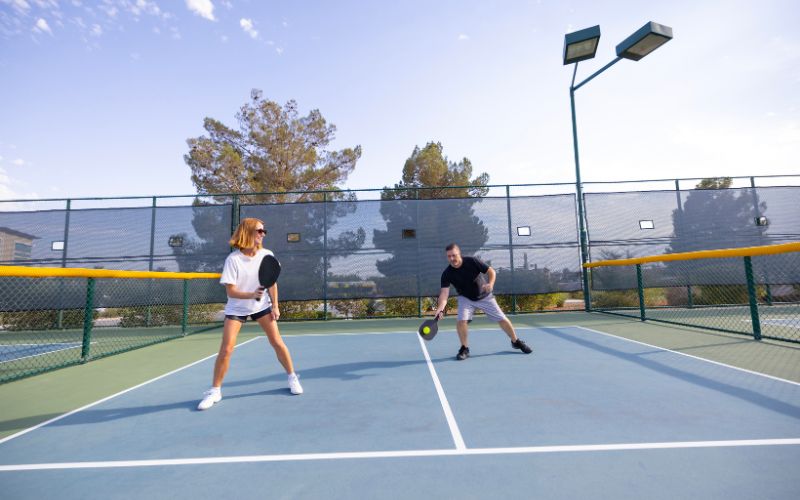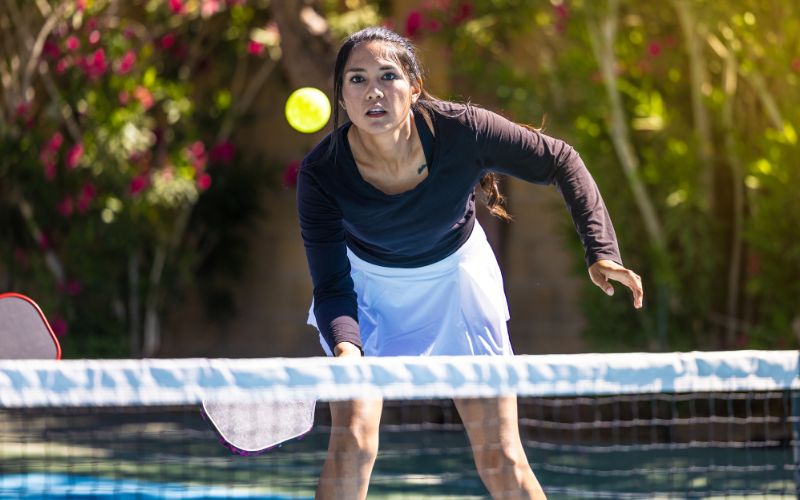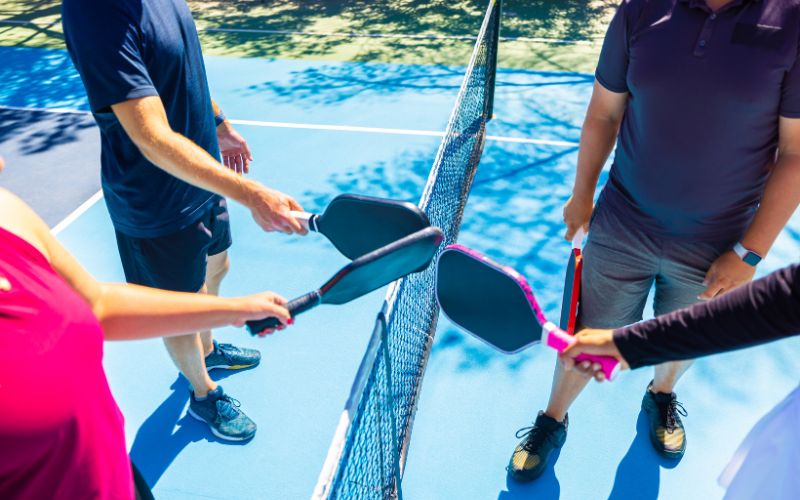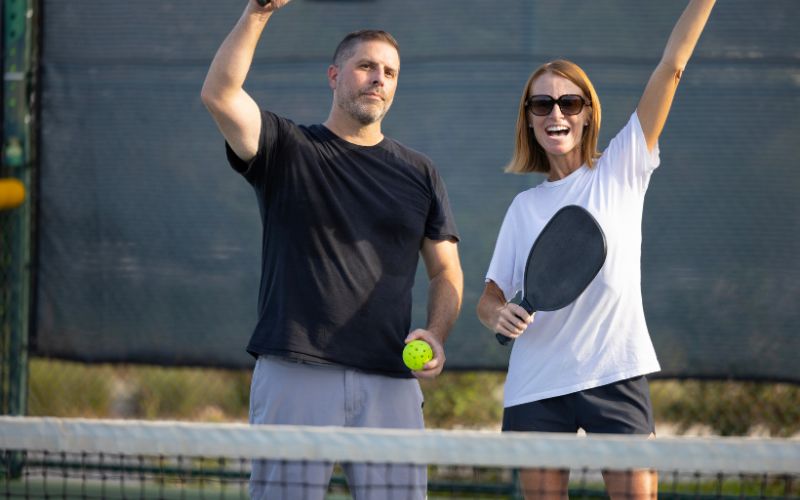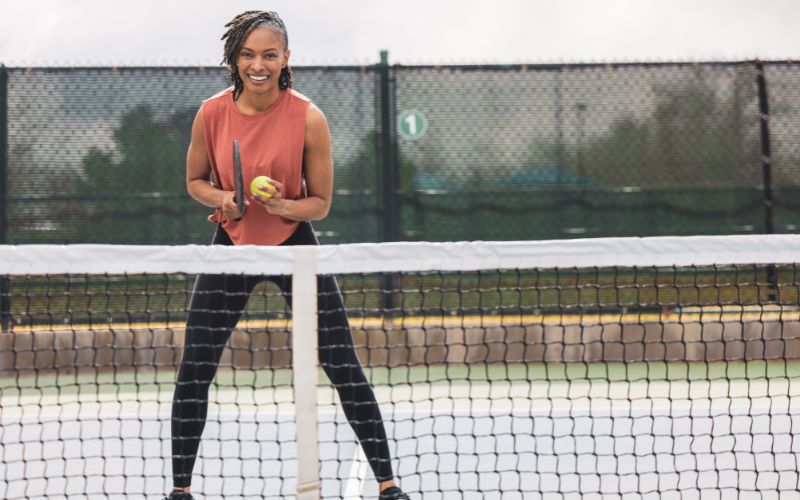Pickleball, a sport cherished for its engaging gameplay and strategic maneuvers, encompasses a myriad of techniques that contribute to its dynamic nature. Among these, the ATP (Around The Post) shot stands as a testament to the sport’s finesse and tactical depth, captivating players with its complexity and strategic implications on the court.
Within the confines of a pickleball court, where precision and strategy converge, the ATP shot emerges as an enigmatic play. This shot, often originating from a ball drop and executed within the heat of a competitive pickleball game, holds immense significance, both in its difficulty level and its potential to sway the course of a match.
In this exploration of “What is ATP in Pickleball: Rules and Significance,” we delve into the intricacies of this advanced technique – the legal shot that involves hitting the ball around the net post, challenging players to execute a move that transcends conventional gameplay. Through this comprehensive analysis, we uncover the rules governing the ATP shot, its strategic importance in the context of a pickleball game, and the methods employed to master this skillful play.
Understanding ATP Shot
The ATP shot in pickleball refers to hitting the ball around the net post, typically from an extreme angle, requiring exceptional skill and precise execution. It’s an advanced maneuver that can alter the game’s dynamics significantly.
The Ideal Moment to Execute an ATP Shot?
It arises during intense dinking exchanges, especially when the ball extends beyond the court’s sidelines. Observing your opponents’ dinking strategies becomes pivotal – are they aiming to push you towards the wider edges and subsequently launch an attack towards the middle?
Engaged in the art of dinking, it’s crucial to anticipate opponents’ next shot that leads you off-court, surpassing the boundaries. Seek out such opportunities as they provide the perfect setting for an ATP shot. Executing an ATP becomes relatively simpler during sharp-angle rallies. A significant factor to consider when preparing for this shot is to foresee and await a low shot in cross-court exchanges. While positioned wide, allow the ball to drop down to knee or shin level, then execute a smooth shot “around the post” into your opponent’s backcourt.
Maintain a low posture with your body and the pickleball paddle. Opting for an ATP shot is more effective when the opponent’s shot is lower, as it presents a challenging return opportunity. Often, opponents will adjust their body angle to defend against the ATP shot. Striking the ATP shot at a low trajectory and at an optimal angle significantly complicates the return over the pickleball net.
Experiment with this technique in your next game. Initially, it might take a few attempts to mentally prepare for the shot, followed by subsequent tries to execute it successfully. However, once you’ve accomplished it, you’ll find yourself anticipating these opportunities more frequently. Enjoy the process and have fun integrating the ATP shot into your gameplay!
Rules and Significance of ATP in Pickleball
Rules Governing ATP Shots
- Explaining the legality of an ATP shot in accordance with pickleball rules.
- Emphasizing the importance of the ball landing in the opponent’s court within the boundaries after executing an ATP shot.
Strategic Significance
- Discussing how executing an ATP shot strategically places pressure on opponents.
- Highlighting the difficulty of defending against such difficult shot due to their unexpected trajectory and placement.
Technique and Execution of ATP Shot
Key Elements of Executing ATP Shot
- Positioning and Angle: Proper positioning on the court to create the angle necessary for the ATP shot.
- Muscle Memory and Practice: Developing muscle memory through consistent practice to execute ATP shots effectively.
- Precision and Strategy: Understanding when to attempt an ATP shot for the best possible outcome during gameplay.
Refinement of Technique
1. Court Positioning and Anticipation
- Strategic Placement: Understanding court positioning is crucial. Players must position themselves optimally to create the right angle for an ATP shot.
- Anticipating Opportunities: Being alert during dinking rallies is key. Look for moments when opponents lead the ball beyond the sidelines, providing an opening for executing an ATP shot.
2. Body and Paddle Position:
- Lowering Body and Paddle: Keeping the body and paddle low is fundamental. This stance helps in maintaining stability and enables a smooth execution of the ATP shot.
- Adjusting to Ball Height: Aiming for lower shots from opponents offers a better chance to execute an effective ATP shot. Waiting for a low ball enables a smoother execution around the post.
Execution Strategies
1. Precision and Timing:
- Accuracy Matters: Striking the ball with precision is crucial. Aiming to land the ball within the opponent’s court while avoiding out-of-bounds areas is key.
- Timing the Shot: Timely anticipation of the opponent’s shot trajectory aids in executing the ATP shot with precision and effectiveness.
2. Practice and Repetition:
- Muscle Memory Development: Consistent practice is imperative. Engaging in drills specifically designed to simulate ATP scenarios helps in developing muscle memory for the shot.
- Real-Game Application: Integrating the ATP shot into actual gameplay situations, especially during competitive matches or practice sessions, allows players to refine their execution under pressure.
Challenges and Adaptation
1. Adapting to Varied Shots:
- Adjusting to Opponent’s Moves: Learning to adapt to different shot angles and heights from opponents is crucial. It enhances the versatility of executing the ATP shot effectively in various game situations.
- Reading Opponent’s Strategies: Understanding opponent patterns and anticipating their moves helps in planning and executing the ATP shot with a higher success rate.
2. Decision-Making and Confidence:
- Confidence in Execution: Building confidence in attempting and executing the ATP shot is essential. Players should trust their skills and decision-making while opting for this strategic play.
- Deciding the Right Moments: Identifying opportune moments to attempt the ATP shot without telegraphing intentions to opponents significantly impacts its success.
The ATP shot in pickleball represents a challenging yet impactful technique that, when executed correctly, can shift the dynamics of a game. Understanding its rules, mastering its execution, and integrating it strategically into gameplay can elevate a player’s performance and add excitement to pickleball matches.
FAQs
1. What exactly is the ATP shot in pickleball?
The ATP (Around The Post) shot in pickleball involves hitting the ball around the net post, typically from an extreme angle. It’s an advanced maneuver requiring exceptional skill and precise execution that can significantly alter the dynamics of the game.
2. When is the ideal moment to attempt an ATP shot during a pickleball game?
The optimal opportunity arises during intense dinking exchanges, especially when the ball extends beyond the sidelines. Observing opponents’ dinking strategies becomes crucial, focusing on their attempts to push you wide or set up attacks towards the middle.
3. What are some key strategies for executing a successful ATP shot?
Maintaining a low body and paddle position is essential. Aiming for lower opponent shots makes executing the ATP shot more effective. Anticipating low shots and smoothly hitting “around the post” from an angle into the opponent’s backcourt increases the shot’s success rate.
4. What rules govern the legality of the ATP shot in pickleball?
According to pickleball rules, the ATP shot must land within the opponent’s court boundaries after executing it around the net post. It’s crucial to ensure the shot remains within legal playing areas for it to be considered valid.
5. How can players refine their technique for executing ATP shots?
Improving court positioning, anticipating opponent moves, and adjusting to varying shot heights are critical aspects. Consistent practice, developing muscle memory, and integrating the ATP shot into real-game scenarios assist players in refining their execution under different competitive pressures.

